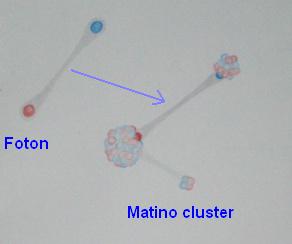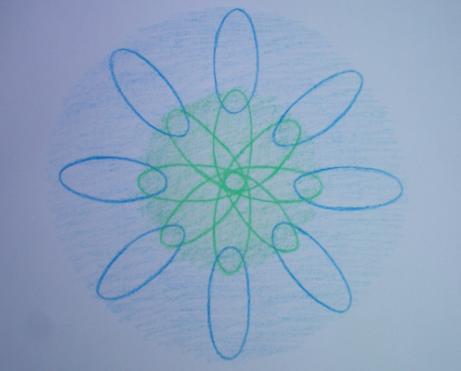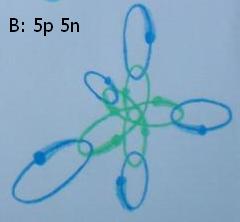Matter
Fotons combine to form all the subatomic particles and matter in the universe.
</span>

Particles
Fotons condense into liquid-like particles, in the same way nuclei and electrons combine to form metal. I have called the basic condensed particle a "matino". The oppositely charged negatinis and positinis make this possible. There is no limit to the size of a matino, but the larger it is, the more likely it will collide with another, and create a 'spatter' of smaller matinos.
In a matino, some of the fotons may be wholly within it, but some are stretched between matinos, providing the gravitational force required for them to orbit around each other - obeying the same laws as planets.
A constant flow of energy
Rather than being static particles, matinos constantly absorb and emit fotons - by constant absorption and emission.
The flow of a stream replaces the water in its ponds. Matinos are like ponds through which fotons flow.This constant flow of energy is a fundamental characteristic of the universe.

While the matino itself appears to be stable, the actual fotons that make up a matino are completely replaced after a period of time. Different situations result in different rates of replacement.
The environment of the matino dictates its stable size. The influences on this environment are the electromagnetic field and gravitational influences from other orbiting particles. The push and pull of these forces control the equilibrium size for each matino.
Matinos and matter
Matinos can create orbital systems (clusters) of any size, held together by bridging fotons. The stability of the system is limited by the mechanical orbits and the probability of collision between matinos. The bond between the two fotinis in a foton is gravity and these "bridging" fotons.
Bridging fotons are the only source of gravitational atraction between particles - even between planets and galaxies - bridging fotons can stretch unlimited distances. They are the mechanism of the interconnectedness of all things.
Spirit matter
Matinos of various sizes with a neutral charge can combine in orbits around each other, held together by gravity. Most of these clusters are quite small, but there are many of them. They constitute a significant part of the mass of the universe. Having matinos with no charge means this form of matter is invisible to our human eyes.
The variety of matino sizes and orbital arrangements is infinite. These non-atomic matino clusters have consciousness and include the spirits that are hosted by human bodies - our 'souls'.
Atomic matter

An atom has 3 zones. An inner neutral core, occupied by neutrons, surrounded by the positive layer of protons held to the neutrons by gravitational orbits. The outer zone of electrons is negatively charged.
Atoms are a special case of matino clusters (orbiting systems). It is a cluster containing charged matinos. The variety of matino sizes is restricted by the charged environment within the atomic system. The outer electrons have restricted orbital arrangements that prevent collisions (described by contemporary physics). This is true also for the inner nucleus. Protons and neutrons are not inactively clumped together in the nucleus.
The attraction between opposite charges, as well as gravitational force, makes atoms possible. This attraction between charges provides the force needed for the orbits of subatomic particles. This force may or may not be due to absorption and emission of fotons.
The Atomic nucleus
Within the atomic nucleus, protons and neutrons orbit around each other in stable arrangements.
Some combinations of nucleons are more stable than others. The likelihood of collision is reflected in the half-life of the atom.This is why isotopes of an atom have different half-lives. The most stable isotope is the one that can produce the most stable nuclear orbiting system.
Radioactivity is the result of collisions between nucleons within the nucleus.
The shorter the half-life of an isotope, the more difficult it is for the system to maintain its stability. Any "particle" that has a measurable and reproducible half life is not a single matino, but an orbiting matino cluster.
The nucleus is not uniform. Protons have a positive charge and repel each other. In the nucleus they make up an outer layer, with neutrons occupying a neutral inner core. The neutrons orbit around each other in the core, and the protons orbit around the neutrons in the outer part of their orbits. Protons do not orbit around each other. This is the orbital arrangement that allows protons to avoid strong repulsion, producing a stable system.

A 2D representation of the atomic nucleus. It shows the neutral core orbits made up of neutrons (green) and the positive outer layer orbits made up of protons (blue).
Small nuclei
The following diagrams are 3D representations of small nuclei. They show how neutrons orbit around each other and a selected proton. Neutrons orbit in pairs or 3 or 4 - depending on the geometry they must create. The diagrams show the most simple arrangements where the number of neutrons and protons is equal. When there are more or less neutrons than protons it is possible for neutrons to "share" protons, to ensure every proton has a neutron to orbit around when it approaches the inner neutral zone.


